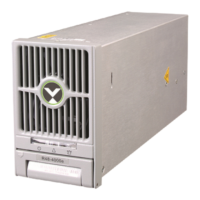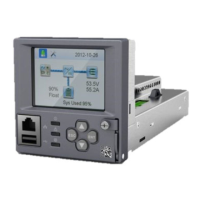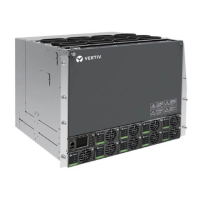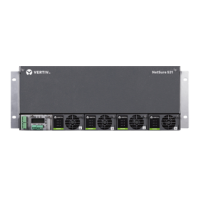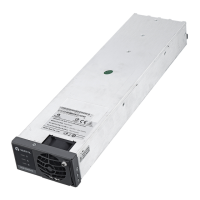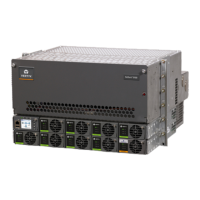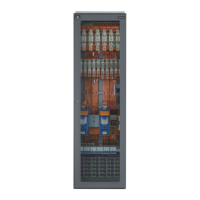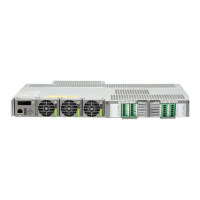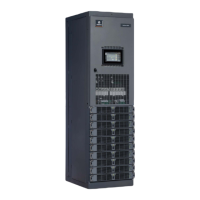NetSure
™
Control Unit (NCU)
User Manual, UM1M830BNA
Spec. No: 1M830BNA, 1M830DNA Code: UM1M830BNA
Model No: M830B, M830D Revision M, May 12, 2017
Fuses
Advance Settings Menu / Fuse Tab.
Power Split Feature
In Power Split applications, the output of the power system
controlled by the NCU can be connected in parallel with an existing
power system. Each system is controlled independently via its own
controller. The NCU power system is referred to as "System A" and
the existing power system as “System B”. The Power Split feature
controls the NCU power system’s (“System A”) output voltage and
rectifiers' current limit so that “System A” shares the load with
“System B”.
Optional Functions: The NCU controller can mimic the equalize
and battery test functions of “System B’s” controller. In addition,
the NCU controller can mimic the low voltage load disconnect
and/or low voltage battery disconnect functions of “System B”.
This is accomplished by supplying digital signals from “System B’s”
controller to the NCU. This allows these functions to remain active
in “System B”.
OVERVIEW
See also “Power Split Feature” on page 6.
How Power Split Works
There are four User adjustable parameters for Power Split. They
are:
Power Split Current Limit Value: Current limit point for
power system designated as “System A” in a "Power Split"
configuration.
Delta Voltage: The offset voltage that the power system
designated as “System A” in a "Power Split" configuration
is set to. It is suggested to leave this value at the default
(0.5 volts).
Proportion Coeff: The proportional coefficient that the
power system designated as “System A” in a "Power Split"
configuration is set to. It is suggested to leave this value
at the default (30%).
Integral Time: The integral time that the power system
designated as “System A” in a "Power Split" configuration
is set to. It is suggested to leave this value at the default
(60 seconds).
The NCU controller uses these parameters to control the load
sharing operation between the two power systems.
Depending on the systems’ configurations, their rectifier
capacities, their distribution load capacities, and the Power Split
configuration; four operating modes can occur.
Low Load Operation
When the total load current demand is lower than the Power Split
Current Limit Value, the NCU power system voltage will be
increased by the programmed DELTA VOLTAGE setting forcing the
NCU power system to carry the load. Make sure that the output
voltage does not exceed the battery float range recommended by
the manufacturer. In this operating mode, no current will be
delivered by the existing power system.
Normal Load Operation
When the total load current demand reaches the Power Split
Current Limit Value, the NCU power system operates in output
current limit and its output voltage will be decreased (up to the
DELTA VOLTAGE setting) in order to regulate the current, allowing
the existing power system to deliver the remaining current. Both
the NCU power system and the existing power system are now
providing current to the load.
High Load Operation
If current demand increases and the existing power system
reaches its current limit setting, float voltage will again begin to
decrease. When the voltage falls below the float setting minus the
DELTA VOLTAGE setting, the NCU system will come out of current
limit and now deliver the additional current necessary to satisfy the
load. This operation may occur when the batteries are being
recharged, such as after a commercial AC failure.
Over Load Operation
If the load current is greater than the combined current capacities
of the NCU system and the existing power system, both power
systems will go into current limit. Both systems and the batteries
will feed the load. The output voltage will depend on the
conditions of the batteries. This operation occurs if the total
capacity of the rectifiers is too low in relation to the need for
increased current.
Operating Modes
Figure 5 illustrates the four modes of operation described above.
The Normal Load Operation is considered to be the normal mode.
In this mode both the NCU system and the existing parallel power
system are both delivering load current. This is main purpose of
using Power Split, to avoid putting the burden of delivering the
entire load onto one of the two power systems.
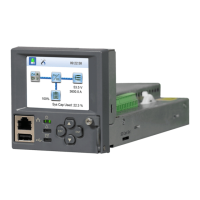
